This website is supported by its readers. If you click one of my links I may earn a commission. I am also a participant in the Amazon affiliates program and I will also earn a commission from qualified purchases.
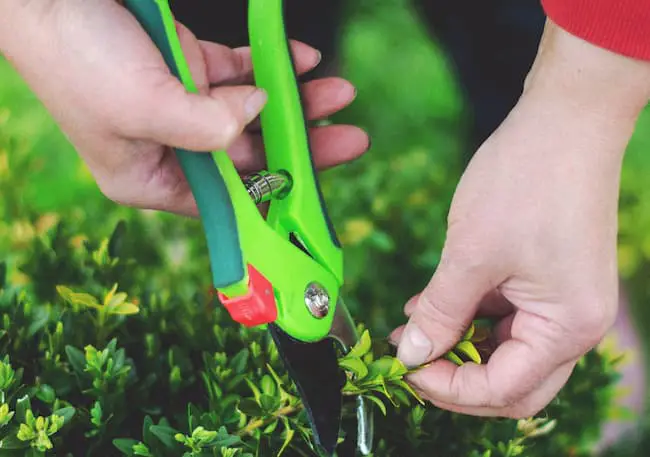
Looking back on my bonsai journey, I cringe at some of the techniques I used to follow. One such problem was trimming my bonsai trees too frequently and over-prune the trees. This got me thinking that many beginners are likely making the same mistake. So can you over-prune a bonsai?
Bonsai trees can easily be over-pruned. You must undertake care to prevent the branches and leaves from being cut too far back or too frequently. This accounts for both maintenance pruning and structural pruning.
Bonsai trees also require time in between trimming sessions to grow and recover.
So exactly how far back should you trim a bonsai tree? And how frequently should you trim a bonsai? Keep reading to find out more!
Just a quick heads up, over the past three years of running Plantpaladin, hundreds of people have asked for product recommendations. As such, You can find my favorite indoor bonsai tree here (link takes you to Bonsaiboy), my favorite outdoor bonsai tree (link takes you to Bonsaiboy), or have a look at all the products I recommend here.
Can you over prune a bonsai tree?
Pruning, trimming, and cutting a bonsai tree are essential to designing bonsai.
After all, developing complicated bonsai tree designs that fall into the cascade, sumo, and semi-cascade style takes several years of pruning and patience.
This general care and pruning can easily lead to the over-pruning of a bonsai.
Over-pruning is one of the major arguments people make for bonsai being a cruel horticultural activity.
I know this was a mistake I made way too much at the start of my bonsai journey.
As such, I got in touch with a few bonsai experts, visited my local botanical gardens, and even undertook a quick survey of 10 plant paladin readers to determine what constitutes over-pruning.
To ensure you have the best post on the web on, can you over-prune a bonsai tree?
To summarise:
Can you over prune a bonsai tree – quick facts
- Bonsai trees can easily be over-pruned.
- The main reason is how easy it is to remove large chunks of your bonsai material (twigs, branches, leaves) in one sitting.
- Many people new to bonsai overdo the amount of pruning they undertake during an individual pruning session.
- On top of this, over-pruning bonsai is common due to frequent pruning of a bonsai tree.
- Many people prune their bonsai every week during the spring and summer. You should avoid this at all costs. Bonsai trees should be trimmed in late winter, at the start of spring, or a week before spring starts. This will allow your bonsai enough time to grow out during the rest of the spring and summer growing months.
- Restraint then should be undertaken when pruning bonsai.
- As a rule of thumb, bonsai trees should only have structural/stylistic pruning work once or twice per year and have general maintenance pruning done a maximum of three times per year. (every few weeks in the spring/summer)
- Doing so will give your bonsai three to four months to recover between maintaining prunes.
- Aim to only prune back dead branches, leaves, and twigs in the first instance in maintenance pruning
- Excessive pruning should not be undertaken on younger or older bonsai trees.
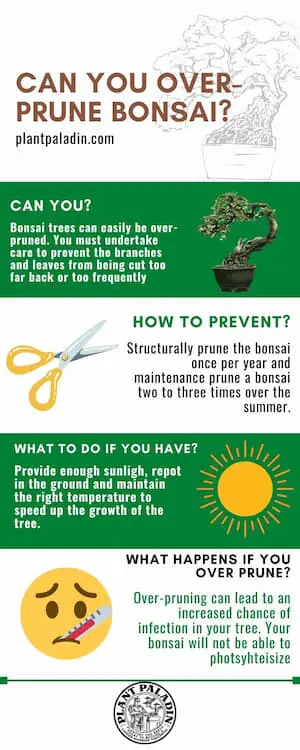
Now, this is quite a lot of information to take in, so let’s explore this in more detail:
How often should you trim a bonsai to avoid over-pruning?
General maintenance pruning should be undertaken every few weeks from the early spring to the late summer. You should not exceed three maintenance pruning sessions during the summer. Structural/stylistic pruning should only be undertaken at a maximum of twice per year.
The best time to undertake structural pruning is just before the spring starts.
Most bonsai thrive with one structural trimming session per year, with slower-growing bonsai species, such as Jade bonsai, only needing structural pruning to be undertaken once every two years.
Maintenance trimming and structural pruning vary greatly from tree to tree and species.
For example, smaller fingertip-sized bonsai trees will have been trained to grow much slower than sizeable imperial-sized bonsai trees.
As a beginner, I know this advice can be a little tricky, especially if you are getting to grips with bonsai, so hopefully, the table below should help guide you on what to do during the times of the year if this is your first time training.
Bonsai pruning timetable by season to avoid over-pruning
Season | Type of pruning required |
Spring | Structural pruning can be undertaken in the early spring - so long as the tree is in good health. If structural pruning is undertaken, utilize maintenance pruning during the same session. Only structural prune the bonsai if the tree is in good health and at least one year has passed since the last structural pruning session |
Summer | One to two maintain pruning sessions between June and August |
Fall | Avoid pruning |
Winter | Structural pruning can be undertaken in the last few weeks of winter of structural pruning was not undertaken in spring. If the tree is in good health. |
Structural pruning can be undertaken in the early spring – so long as the tree is in good health. If structural pruning is undertaken, utilize maintenance pruning during the same session. Only structural prune the bonsai if the tree is in good health and at least one year has passed since the last structural pruning session
Tree energy flow and over-pruning?
So one of the reasons why it is so easy to over-prune bonsai trees is that we don’t understand the science behind bonsai.
Like animals, many deciduous bonsai tree species have different energy levels as the year passes.
For example, during the middle of spring, your tree will have lower energy levels as it will use most of its energy to push out new leaf growth during the growing season.
Pruning your bonsai tree with lower energy levels might not be the best idea.
Instead, you could wait for the end of winter, just before spring starts, when your tree will have a lot of stored energy that it can use to heal the tree after structural pruning.
This is why undertaking maintenance trimming sessions during the summer, when the tree has ample light and plenty of energy in the tree, will mean it will have enough time to recover.
Structural vs. maintenance over-pruning
So, as mentioned earlier on there are two main types of pruning:
- Structural pruning – Where large amounts of the tree and trimmed back and pruned to create a structural design in your bonsai tree.
- Maintenance pruning – Undertaken to eliminate any dead twigs, branches, and leaves and generally to clean up your tree’s appearance.
In my experience, over-pruning tends to occur a lot more for people who undertake structural pruning than compared with maintenance pruning.
This is because most maintenance pruning will trim back dead branches or small leaves without removing large tree sections.
This is why you can undertake maintenance every few weeks without many problems.
Structural pruning, if undertaken incorrectly, can be dangerous.
You will not just be removing small dead branches, twigs, and leaves but instead be removing healthy leaves, branches, and even parts of the trunk to create the ideal-looking tree.
To prevent over-pruning caused by structural pruning
- Only structurally prune your tree once per year for most tree species. One year in between structural tree sessions will give your bonsai enough time to heal.
- Ensure structural pruning is undertaken on young, healthy trees.
- Avoid other bonsai training methods, such as wiring and deadwood, if structural pruning has just been completed.
- Remove no more than 40 to 50% of the tree structure – Removing too much will cause your tree to not photosynthesize or absorb nutrients from its soil effectively.
To prevent over-pruning caused by maintenance pruning
- Only maintenance prune your bonsai one to three times during the summer
- Aim to remove dead branches, twigs, and leaves
- Aim to remove no more than 30% of the bonsai’s material in the most extreme cases – most maintenance pruning will only remove between 5 to 20% in most instances.
- Trim back the leaves at the petiole and trim back branches and twigs until they have 2 to 3 leaves on them to promote new growth.
- Wait 4 to 6 weeks between maintenance pruning sessions to allow your bonsai to recover.
How much material should you remove to avoid over-pruning bonsai?
To avoid over-pruning a bonsai tree, remove no more than 50% of bonsai material ( branches, twigs, trunks, and leaves) when undertaking structural pruning. Remove between 5% to 30% of material when undertaking more frequent maintenance pruning.
So what does this look like when trimming back branches and tree leaves?
Let’s explore this below:
How far back should you trim bonsai branches to avoid over-pruning?
So the most common type of pruning you will be undertaking when pruning bonsai trees will be removing the tree branches.
You will remove branches either to promote new growth of new branches or to maintain the size of the tree.
So how much of the branch should you remove without worrying about damaging or over-pruning the tree?
Well, typically, you should only remove the branches that exceed the overall silhouette of the tree.
Any branches that are in good condition and sit within the bonsai tree style should remain unharmed.
Hopefully, the image below should help give an idea of what branches should be removed.
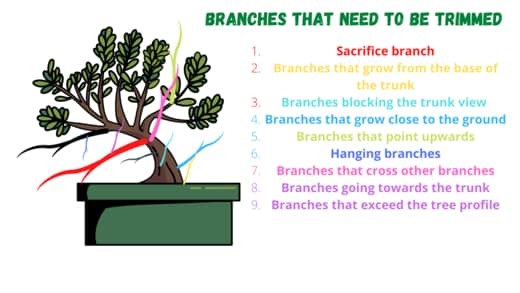
To remove and trim back a bonsai branch, select a branch you would like to trim.
If you would like to trim this branch to sprout new growth, then trim the branch until only two to 3 leaves remain.
Alternatively, if you want to remove this branch entirely, then trim the branch back at the tree and use sealant to prevent the trunk from becoming infected.
Once again, remember only to trim back no more than 50% of the branches of your bonsai tree using structural pruning.
How far back should you trim bonsai tree leaves to avoid over-pruning?
Removing bonsai leaves, also known as defoliating a bonsai tree, adds more depth and leaves to a bonsai tree’s canopy.
While it might sound counterintuitive, trimming leaves at the petiole will cause two new leaves to sprout from the bud.
While you can defoliate the entirety of the tree to spout new growth, I would partially defoliate the leaves on the tree.
You will prevent over-pruning, especially if you trim branches and make structural changes to the tree this way.
Only aim to defoliate once during the growing season to give your tree plenty of time to recover.
What to do if you have over-pruned your bonsai tree?
So if you have over-pruned your bonsai tree, fret not; there are a few things you can do to try and limit the damage.
These include:
Plant your bonsai in the ground
When severe damage has impacted your bonsai tree, we need to optimize the health of your bonsai, essentially putting it on life support.
While healthy bonsai trees have no issue being kept in a shallow pot, if you have over-pruned your bonsai, consider planting your tree in the ground (weather permitting, of course)
This will give your bonsai unlimited access to nutrients, water, and oxygen in the soil, allowing your bonsai tree to heal back faster than it would if you kept it in a pot.
Provide ample sunlight
Bonisa trees (like all plants and trees) get their food from sunlight.
If you have damaged your bonsai tree, ensure it gets between 6 and 8 hours of direct sunlight per day to speed up its recovery process.
Aim to place your bonsai in the brightest spot in your backyard/garden.
If you live in milder conditions, then consider investing in artificial light.
Do not repot the tree
Aside from repotting, I would avoid repotting your bonsai if you have over-pruned it into a new pot.
This is because repotting bonsai trees requires a lot of aftercare and is stressful for your bonsai.
This can further pressure your bonsai and prevent it from healing from over-pruning.
Maintain the right temperature
Most (not all) bonsai trees are from tropical warmer climates.
As such, maintain a warmer temperature that best matches the natural condition of your bonsai tree species.
Small greenhouses or propagators work very well for this.
What are the problems with over-pruning bonsai?
Over-pruning your bonsai tree will result in reduced nutrient absorption, the inability to photosynthesize efficiently, and a bonsai tree that is more susceptible to fungal, bacterial, and insect infestations.
Pruning undertaken too frequently will also scar your tree, stings its growth, and in severe cases, kill your bonsai.
How to prevent over-pruning your bonsai tree?
To prevent over-pruning a bonsai tree, only structurally prune the bonsai once per year and maintenance prune a bonsai two to three times over the summer. Ensure your bonsai tree has plenty of time to grow between pruning sessions.
For best results, I wait one year between structural prunes and four to six weeks between maintenance prunes.
Which bonsai tree species can recover from over-pruning?
Fast-growing tree species used for bonsai, such as Chinese Elm, Maple, Ficus, and Pine, will recover best from over-pruning. This is because these fast-growing species will heal much quicker when going through strenuous activities such as over-pruning.
These species are amongst the most beginner-friendly bonsai tree species available.
Species that will require extra help if over-pruned are slower-growing tree species such as Wisteria, Fukien Tea, and Jade.
For more details, check out the table below:
Bonsai species | Growth type | Time to maturity | Average growth per year |
Chinese Elm | Fast | 3 years | 12 to 36 inches |
Juniper | Moderate | 4 years | 5 to 12 inches |
Jade | Slow | 5 years | 2 to 5 inches |
Maple | Fast | 3 years | 12 to 36 inches |
Fukien Tea | Slow | 5 years | 2 to 5 inches |
Ficus | Fast | 3 years | 12 to 36 inches |
Wisteria | Slow | 5 years | 2 to 5 inches |
Cotoneaster | Moderate | 4 years | 5 to 12 inches |
Pine (most varieties) | Fast | 3 years | 12 to 36 inches |
Azalea | Slow | 5 years | 2 to 5 inches |
Survey results
Finally, I wanted to finish by asking 20 plant paladin readers how much of a bonsai tree should be pruned in one session.
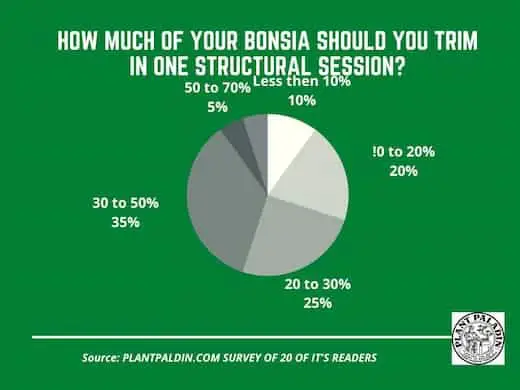
This should help you know how much you should be pruning your bonsai.
I also asked how frequently they structurally prune their bonsai tree, and here were the results:
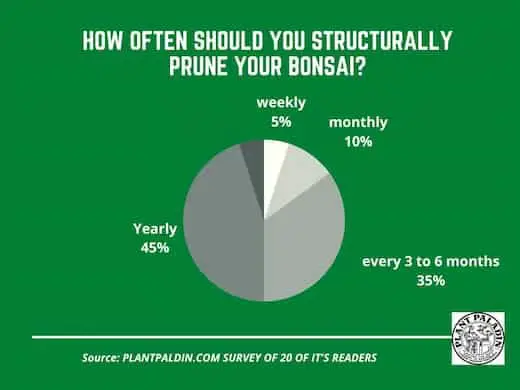
My top picks for the gear you will need!
So like I mentioned earlier, over the past three years of running PlantPaladin, hundreds of people have asked me for my recommendations on the best bonsai gear on the market.
Having spent thousands of dollars on bonsai items these past few years and tested at least 100 bonsai-specific products, I’ve listed my favorite products below – All of which I highly recommend and think you can get great value.
They can purchase directly by clicking the link to take them to Amazon.
Bonsai Tool Set: One of the significant challenges I’ve had is finding a toolset that was not only durable but didn’t break the bank. SOLIGT has recently developed a fantastic bonsai tool set that covers all the tools you need to trim, prune, and repot your trees. – You can grab it here.
Complete Bonsai Set: Many of you will want to grow your bonsai trees entirely from scratch, but finding the varicose seeds, pots, and other items in one place can be challenging. Leaves and Sole then have created a complete bonsai set that I’ve personally used that ticks all the boxes. You can grab it here.
Bonsai wire: The number of times I’ve run out of wire for my bonsai or purchased cheap bonsai wire that doesn’t do the job is embarrassing for me to admit. After a lot of trial and error, I found that using Hotop’s aluminum bonsai wire is one of the best options on the market. This can easily be used for both indoor and outdoor bonsai. You can grab it here.
This post was written by Fehed Nicass who has been passionate about bonsai for over 3 years. He currently resides in the UK and works in sales.
